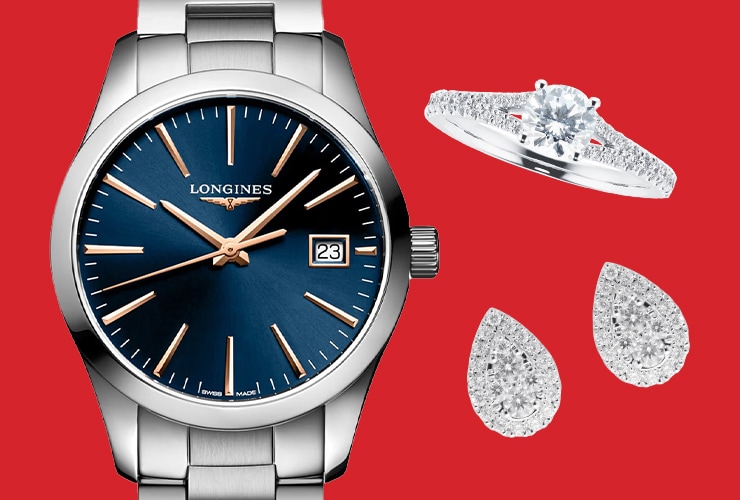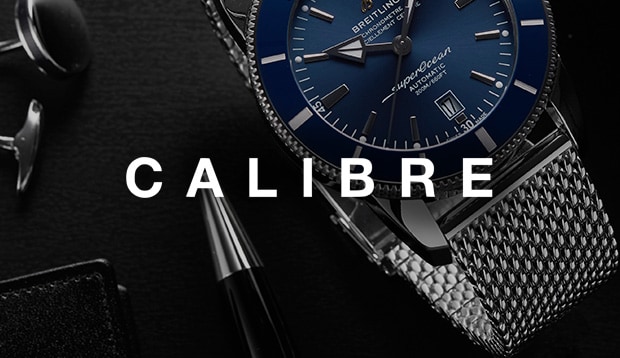-
SALE
Sale JewellerySale WatchesBy Price
-
Diamonds
By Category
-
Engagement
By Category
-
Weddings
Featured
-
Jewellery
By CategoryBy Metal TypeBy GemstoneBy BrandBy Edit
-
Watches
By CategoryBy CollectionBy Luxury BrandBy Designer Brand
-
Rolex
FeaturedBy Collection
- Rolex Certified Pre-Owned
-
Brands
FeaturedBrands A-Z
-
Gifts
By CategoryBy PriceBy Popular Brand
-
Pre-Owned
By CategoryBy Brand
-
Sell Your Watch
Sell your watchWe will expertly assess your watch and offer you
a competitive and accurate valuation for the
watch you wish to sell to us.Free Instant Valuation
Drop off at any Showroom
Unrivalled Knowledge & Expertise - Editorial
- Shop by Category
- SALE
- Diamonds
- Engagement Rings
- Weddings
-
Jewellery
- Back
- Jewellery Offers
- Shop All Jewellery
- Jewellery Home
- By Category
- By Metal Type
- By Gemstone
-
By Brand
- 886 by The Royal Mint
- Amor
- Bijoux Birks
- BOSS
- Calvin Klein
- Chopard
- Emporio Armani
- Fabergé
- FOPE
- FRED
- Georg Jensen
- Goldsmiths
- Gucci
- Jenny Packham
- Kiki McDonough
- Lauren By Ralph Lauren
- Mappin & Webb
- Marco Bicego
- MARIA TASH
- Messika
- Michael Kors
- Olivia Burton
- Pasquale Bruni
- Pomellato
- Repossi
- Roberto Coin
- Skagen
- Susan Caplan
- SUZANNE KALAN
- SWAROVSKI
- Ted Baker
- THOMAS SABO
- Tommy Hilfiger
- By Edit
-
Watches
- Back
- Watch Offers
- Shop All Watches
- Watches Home
- By Category
- By Collection
-
By Luxury Brand
- Rolex
- Rolex Certified Pre-Owned
- BALL
- Bamford
- Baume & Mercier
- Bell & Ross
- Blancpain
- Breitling
- Bremont
- Cartier
- CHANEL
- Chopard
- DOXA
- Frederique Constant
- Girard-Perregaux
- Glashütte Original
- Grand Seiko
- Gucci
- Hublot
- ID Genève
- IWC Schaffhausen
- Jaeger-LeCoultre
- Junghans
- Keris
- Longines
- MeisterSinger
- Montblanc
- Nivada Grenchen
- NOMOS Glashütte
- NORQAIN
- OMEGA
- Oris
- Panerai
- Piaget
- Rado
- RAYMOND WEIL
- TAG Heuer
- TUDOR
- Ulysse Nardin
- ZENITH
- By Designer Brand
- Rolex
- Rolex Certified Pre-Owned
-
Brands
- Back
- View All Brands
-
A-Z
- Rolex Watches
- Rolex Certified Pre-Owned
- 886 by The Royal Mint
- Accurist
- Amor
- Arnold & Son
- BALL
- Bamford
- Baume & Mercier
- Bell & Ross
- Blancpain
- Bijoux Birks
- BOSS
- Breitling
- Bremont
- BVLGARI
- Casio
- Calvin Klein
- Cartier
- Certina
- CHANEL
- Chopard
- Citizen
- Czapek
- DOXA
- Emporio Armani
- Encelade 1789
- Fabergé
- FOPE
- FRED
- Frederique Constant
- Garmin
- Georg Jensen
- Gerald Charles
- Girard-Perregaux
- Glashütte Original
- Goldsmiths
- Grand Seiko
- G-SHOCK
- Gucci
- Hamilton
- Hublot
- ID Genève
- IKEPOD
- IWC Schaffhausen
- Jacob & Co
- Jaeger-LeCoultre
- Jenny Packham
- Keris
- Kiki McDonough
- G-SHOCK
- Lauren By Ralph Lauren
- Longines
- Louis Erard
- Mappin & Webb
- Marco Bicego
- MARIA TASH
- Maurice Lacroix
- Michael Kors
- Messika
- Montblanc
- Nivada Grenchen
- NOMOS Glashütte
- NORQAIN
- Olivia Burton
- OMEGA
- Oris
- Panerai
- Parmigiani Fleurier
- Pasquale Bruni
- Piaget
- Pomellato
- QLOCKTWO
- Rado
- RAYMOND WEIL
- Repossi
- Roberto Coin
- Rolex
- Rolex Certified Pre-Owned
- Seiko
- Skagen
- Susan Caplan
- SUZANNE KALAN
- SWAROVSKI
- TAG Heuer
- Ted Baker
- THOMAS SABO
- Tissot
- Tommy Hilfiger
- TUDOR
- Ulysse Nardin
- Vivienne Westwood
- William Wood Watches
- WOLF
- ZENITH
- Gifts
-
Pre-Owned
- Back
- Shop Pre-Owned Watch Sale
- Shop All Pre-Owned
- Pre-Owned Home
- By Category
-
By Brand
- Rolex Certified Pre-Owned
- Pre-Owned Patek Philippe
- Pre-Owned TAG Heuer
- Pre-Owned Cartier
- Pre-Owned Jaeger-LeCoultre
- Pre-Owned Breitling
- Pre-Owned OMEGA
- Pre-Owned Longines
- Pre-Owned Tudor
- Pre-Owned IWC
- Pre-Owned Panerai
- Pre-Owned Blancpain
- Pre-Owned Breguet
- Pre-Owned Chopard
- Pre-Owned Rado
- Pre-Owned Vacheron Constantin
- Pre-Owned Zenith
- Sell Your Watch
- Editorial
- My Account
- Wishlist
- Store Finder
- Book an Appointment
- Help & Support
A Guide To Quartz Watch Movements
By Sarah Jayne Potter | 5 minute read

A watch’s movement, also known as its calibre, is often thought of as the engine to a timepiece. A sophisticated network of intricate parts that power the hands on the dial and all complications. In this guide we’ll take a look at the quartz movement’s compelling history and explore the fundamentals of how one works; along with the benefits it can provide and maintenance required.
A brief history of quartz watch movements
Owing to a prestigious history and heritage of exquisite craftsmanship, Switzerland sets a tremendous standard for all other watchmakers. During the 16th century, the Swiss watch industry steadily became the home of fine watchmaking and by the end of the 18th century, Geneva was exporting over 60,000 watches per year. One of the innovations of this time was the perpetual watch – the blueprint for today’s self-winding timepiece.
However, it was not to be smooth sailing for Switzerland forever. Throughout the 1970s and 80s, Japanese watch company Seiko successfully derailed the industry with what’s commonly referred to as the Quartz Crisis. The Japanese brand’s introduction of the world’s first commercially available quartz-clock wristwatch – the Astron – in 1969 caused incredible upheaval in the traditional watch industry, which was late to adapt to these changes in technology. The Astron showcased that instead of an intricate network of mechanics, a timepiece could be simply powered with a small crystal, battery, and motors.
The lure of this new, cutting-edge technology that could more accurately tell the time and was significantly less costly, became irresistible. Watchmakers in the USA and Far East began to thrive at the expense of the traditional brands. It’s estimated that during this period around 900 Swiss watch brands went bankrupt, and two thirds of the workforce lost their jobs.
After several decades of industry upheaval, and with watchmakers all over the world taking on the challenge to create the slimmest, most high-quality quartz timepieces, this bleak period in Switzerland’s watchmaking history soon subsided. Quartz technology was embraced by the traditionalists and has since gone on to thrive with advances in innovation, such as solar- and motion-powered watches.
For the traditionalists, quartz watches still can’t hold a candle to the masterful engineering of a mechanical movement watch. However, a quartz is well worth the consideration, owing to such precise accuracy alongside considered detail and elegant aesthetics.
In fact, the Quartz Crisis is now nothing more than a past chapter in the long and prestigious history of Swiss watchmaking. Its acceptance of quartz as a viable power source has led to the mark of ‘Swiss quartz movement’ being a signifier of excellence in both heritage and craftsmanship.
What is a quartz watch movement?
A quartz watch movement uses a battery as its primary power source. It’s the force behind the dial that drives the hands and powers all complications. The battery sends an electrical current through a small quartz crystal, which electrifies it and creates vibrations. Those vibrations keep the movement oscillating and power the motor that moves the watch hands. Unlike the smooth sweeping motion of a mechanical movement, the second hand of a quartz watch moves in distinct individual ticks.
It’s highly likely that a quartz movement is behind the functionality of a standard, everyday timepiece owing to its meticulous reliability. In fact, around 90% of the world’s watches use a battery as their power source. The maintenance is minimal and the price tag is much more cost effective. Couple this with the fact that the timekeeping of a quartz watch is the most accurate available, and it becomes clear why the emergence of quartz caused an upheaval within the world of horology.

How does a quartz watch movement work?
- Battery
- Quartz crystal
- Stepping motor
- Dial train
- Watch hands
The battery sends electricity through an integrated circuit to the quartz crystal, which is shaped like a tuning fork.
The electric charge makes the crystal vibrate at a rate of 32,768 times per second. These oscillations are detected by the circuit and turned into electric pulses sent to the stepping motor.
The electrical pulses drive the stepping motor which converts the electrical energy into mechanical power that turns the gears.
The dial train moves the hands of the watch, and each pulse is sent here at a rate of one per second.
This pulse drives the watch hands, giving them their distinct individual ticking motion.
To understand why a quartz movement provides superior accuracy over any other type of movement, it’s useful to look at the mechanical watch first. Within a mechanical movement, energy supplied by winding the watch must be sent through its many various parts, all of which use up the energy and therefore incremental power is lost.
With a quartz movement however, there are less moving parts to consume the energy, so any power needed to keep the crystal oscillating is retained.
Benefits of a quartz watch movement
Superior Accuracy
A quartz crystal always oscillates at the same frequency. This natural rhythm is much more reliable than the physical movements of a mechanical watch, and results in exceptional accuracy.
More Affordable
Quartz watches are battery powered and therefore require less parts and haute watchmaking craftsmanship than their intricate mechanical counterparts. Together this results in a more affordable product.
Minimal Maintenance
Other than the occasional battery replacement every one to two years, the maintenance needed for a quartz watch is very low. There’s no need to worry about winding or any other type of interference to ensure it keeps ticking.
More durable
There are far fewer moving parts within a quartz watch compared to a mechanical one, which mitigates the number of things that could require repair. A quartz watch can be extremely robust and run for a lifetime.
Maintenance of a quartz watch
Change the battery promptly
When the time comes to change the watch’s battery, be sure to do so as soon as possible. Dead batteries will leak and a major service will be required to clean the timepiece up. Fortunately a battery change is a simple affair that all watchmakers can undertake.
Get your timepiece regularly serviced
Just like all luxury timepieces, a quartz watch will need a service. However, because it has so few moving parts, there’s less to keep in working order and a professional service is only needed once every 10 years. Although it’s always a good idea to double check this against your particular watch brand’s advice.
Clean it regularly
Getting into the routine of giving your timepiece a light daily dust, and a more thorough soap-and-water clean every three to four months, will ensure it stays immaculate and gleaming.
Consider proper storage
A purpose-made watch box or the original display box are two of the best ways to keep your timepiece safe, and free from any bumps or scratches, when it’s not being worn.
Sign Up For Calibre Newsletter
Get a round up of the latest stories from Calibre every month, directly to your inbox.
© 2025 Goldsmiths
Goldsmiths is a trading name of Watches of Switzerland Company Limited. Registered Office: Aurum House, 2 Elland Road, Braunstone, Leicester, LE3 1TT, Registered in England and Wales, Company number 00146087. Registered VAT Number 834 8634 04. Watches of Switzerland Company Limited acts as a broker and not a lender and offers finance from Secure Trust Bank PLC trading as V12 Retail Finance and PayPal UK Ltd, 5 Fleet Place, London, United Kingdom, EC4M 7RD trading as PayPal Credit. Watches of Switzerland Company Limited is authorised and regulated by the Finance Conduct Authority. Our registration number is 308710. *Credit is provided subject to affordability, age and status. Minimum spend applies. Terms and Conditions apply. UK residents only. Not all products are regulated by the Financial Conduct Authority and FOS protection will not be extended to unregulated agreements. Please note the Consumer Credit Act states that should your purchase / loan amount cost more than £30,000 you will not be covered under Section 75 of the Consumer Credit Act.
*Next day delivery available on most items. See product pages for more information.









